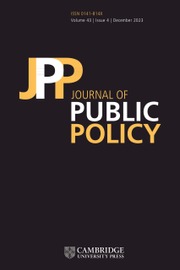Introduction
A substantial body of research on assessments of national incumbents during the COVID-19 pandemic has pointed to the existence of a “rally-around-the-flag” effect (De Vries et al. Reference De Vries, Bakker, Hobolt and Arceneaux2021; Bol et al. Reference Bol, Giani, Blais and Loewen2021; Schraff Reference Schraff2021; Fernandez-Navia et al. Reference Fernandez-Navia, Polo-Muro and Tercero-Lucas2021; Sibley et al. Reference Sibley, Greaves, Satherley, Wilson, Overall, Lee, Milojev, Bulbulia, Osborne, Milfont, Houkamau, Duck, Vickers-Jones and Barlow2020). This body of research argues that confronted by pandemic-induced anxiety, voters found security in political trust and ended up endorsing draconian health safety measures. For example, studying the effect of local exposure to COVID-19 on voting behavior and electoral outcomes based on data from regional elections held in Spain, Fernandez-Navia et al. (Reference Fernandez-Navia, Polo-Muro and Tercero-Lucas2021) find a substantial increase in the probability of voting for nationalist parties. In the same vein, comparing matched samples of New Zealanders from the pre-lockdown and lockdown period, Sibley et al. (Reference Sibley, Greaves, Satherley, Wilson, Overall, Lee, Milojev, Bulbulia, Osborne, Milfont, Houkamau, Duck, Vickers-Jones and Barlow2020) find higher levels of mental distress and higher levels of patriotism in the post-lockdown sample. Thus, troublingly for democratic theory, the implication seems to be that in pandemic-like settings, incumbents are immune from the standard punishment expectation of “performance voting” that is operative in “normal” times (De Vries and Giger Reference De Vries and Giger2014).
In contrast to the rally-around-the-flag arguments, a second line of research observes that voters were neither politically disengaged nor unquestionably accepting of the status quo during the pandemic (Lowande and Rogowski Reference Lowande and Rogowski2021; Bernardi and Gotlib Reference Bernardi and Gotlib2022; Neundorf and Pardos-Prado Reference Neundorf and Pardos-Prado2022; Kritzinger et al. Reference Kritzinger, Foucault, Lachat, Partheymüller, Plescia and Brouard2021; Noury et al. Reference Noury, François, Gergaud and Garel2021; Graham and Singh Reference Graham and Singh2024; Henderson and Oden Reference Henderson and Oden2024; Trüdinger et al. Reference Trüdinger, Hildebrandt, Sand and Rieker2022; Hrbková and Kudrnáč Reference Hrbková and Kudrnáč2024). Of particular relevance for us is a study by Bernardi and Gotlib (Reference Bernardi and Gotlib2022), which examines the relationship between mental stress and mental health on the one hand and satisfaction with government performance on the other. Leveraging the voluminous psychological literature on COVID-19, they hypothesize that both pandemic stressors and worsening mental health during the pandemic affected assessments of how incumbents managed the crisis negatively. Data from two online surveys conducted in Britain in August 2020 and March 2021 is used to confirm these predictions.
This study moves this debate forward in three important ways. First, we leverage a critical distinction in the psychological literature between social and non-social sources of mental stress to argue that psychological challenges stemming from social stress are more likely to be related to negative assessments of how governments addressed the pandemic. We also show that social coping is more likely to be associated with positive assessments of pandemic management than emotion-focused coping. Second, we argue that the partisan identity of incumbents in federal and state-level government cabinets crucially moderates the effect of the psychological implications of COVID-19. Specifically, certain forms of mental stress/coping strategies will only affect political attitudes during the pandemic when the same party is in power at both levels of government. This point about clarity of responsibility, or as Hobolt, Tilley & Banducci (Reference Hobolt, Tilley and Banducci2013, 165) refer to it, “government clarity” – when the same party is in power at the federal and state level – is critical for testing the political consequences of the psychological effects of COVID-19 beyond non-unitary political contexts, especially in federal democracies with overlapping powers of central and state governments. Third, we support these observations using survey data from India, a democracy about one-third the geographic size of the USA with nearly three times the population size and a comparatively low level of economic development, rather than high-income countries with stable and institutionalized welfare systems that have been the subject of much of the extant research.
The empirical context of our study is the controversial lockdown imposed in March 2020 in the midst of the first wave of the COVID-19 pandemic in India. Specifically, our analysis is based on data from three novel cross-sectional surveys of different random samples conducted in the first, second, and third week of June 2020, respectively, after the lockdown was officially revoked. For each survey, we analyzed the propensity to vote for the nationally incumbent Bharatiya Janata Party (BJP), if a hypothetical national election were to be held on the day of the survey as indicated in the survey question. We find that the propensity to vote for the BJP was negatively correlated with a latent factor that captured variation in pandemic stress from routine disruptions in mobility (Week 1); a latent factor that captured variation in mental health (Week 2); and two latent factors that captured variations in emotion-focused coping (Week 3). We show that these effects are strongest in states governed by the BJP, the same party that governs at the federal level.
The rest of this article is structured as follows. Section 2 presents our theoretical framework. Section 3 discusses the data and methods used to assess our theoretical arguments. Section 4 presents our empirical findings. Section 5 concludes.
Theory
Our starting point is a large body of research on the effect of mental health challenges on political participation (Burden et al. Reference Burden, Fletcher, Herd, Jones and Moynihan2016; Couture and Breux Reference Couture and Breux2017; Landwehr and Ojeda Reference Landwehr and Ojeda2021; Ojeda Reference Ojeda2015; Stockemer and Rapp Reference Stockemer and Rapp2019; Chiu and Chan Reference Chiu and Chan2007). Following Ojeda (Reference Ojeda2015), mental health challenges impose large costs on public forms of political participation, such as voting, by reducing the enthusiasm necessary to do so. However, extraneous factors can make participation by mentally distressed individuals possible by reducing these costs. For example, Couture and Breux (Reference Couture and Breux2017) observe that participation is higher in national elections since the information barrier for assessing parties and candidates is lower compared to subnational elections, which generate less media attention. Alternatively, less intrusive forms of political activity, such as signing online petitions, may be more attractive (Burden et al. Reference Burden, Fletcher, Herd, Jones and Moynihan2016; Chiu and Chan Reference Chiu and Chan2007).
Taking these arguments forward from political participation in “normal” times to political attitudes during crisis situations, this study examines how mentally distressed individuals responded to draconian government safety measures during the COVID-19 pandemic. Our theoretical and empirical approach builds on Bernardi and Gotlib (Reference Bernardi and Gotlib2022), who propose and test hypotheses about the effect of pandemic stressors and mental health on satisfaction with governmental performance.
For the purposes of this study, we use the term pandemic stress when referring to mental stress, which as per standard usage, we define to mean the immediate negative affect from external shocks, and mental health to mean overall psychological well-being (Bernardi and Gotlib Reference Bernardi and Gotlib2022, p. 426). In addition, we introduce the concept of coping. Though studied widely in psychological research as an important component in how individuals navigate psychological well-being over the long term, this concept, to the best of our knowledge, has received little attention in the political psychology literature on COVID-19. Following Na et al. (Reference Na, Yang, Mezo and Liu2022, 2–3), we define coping as referring to “behavioral responses using one’s own resources to minimize the physical, psychological or social harm of a situation, such as creating a sense of coherence, exercising self-control, developing a sense of identity and purpose in life.”
In what follows, we posit hypotheses about mental stress, mental health, and coping, in that order. We chose this sequencing because of the structure of the dataset that we use to test our hypotheses. Specifically, the dataset comprises of three waves of surveys, of which the first survey fielded questions on mental stress, the second survey on mental health, and the third survey on coping.
How does mental stress and mental health affect how individuals evaluate the policy choices made by incumbent governments in crisis situations, such as calling for lockdowns at short notice in the midst a pandemic? Here, we follow Bernardi and Gotlib (Reference Bernardi and Gotlib2022), who delineate plausible mechanisms linking each variable to political attitudes. On the one hand, contrary to the rally-around-the-flag arguments, pandemic-induced stress may be associated with negative assessments of government performance by promoting more, not less, information-seeking among those who are negatively affected. On the other hand, individuals who suffer from poor mental health may concentrate more on negative cues and under-estimate potential benefits of lockdowns and other government health safety measures. Consequently, these interventions might trigger a desire among such individuals to regain control of one’s own life. Punishing the incumbent party could be one way to channel that need, particularly when political competition is high. It is instructive to note that Bernardi and Gotlib (Reference Bernardi and Gotlib2022) also offer a mediation hypothesis linking pandemic stress to negative assessments of government health safety measures via its effect on mental health. We abstract from this hypothesis in the present study since our data does not allow us to test the hypothesized link.
Taking Bernardi and Gotlib’s (Reference Bernardi and Gotlib2022) observations as our point of departure, we propose that not all types of mental stress will be equally salient in the decision to endorse executive decisions in the midst of pandemic-like conditions. Here, we leverage a crucial distinction made by the psychological literature between social and physical stress. According to Crow and Colabianchi (Reference Crow, Colabianchi, Loue and Sajatovic2008, 749), social stress is distinct from physical stress in that unlike the latter, which emanates from stressors that tax the human physiology directly, it originates from factors such as social isolation, unhappy marriage or partnership, socioeconomic disadvantage etc. Most importantly, this form of stress can be as deleterious in its consequences as physical stress because it can directly produce negative psychological states, such as, lack of a sense of purpose or lack of self-esteem (Kawachi and Berkman Reference Kawachi and Berkman2001, 459). In the same vein, research on coping, including a study of mental health in the context of COVID-19 in India (Ahuja Reference Ahuja2022), has typically distinguished between problem-focused, emotion-focused, and social support-seeking coping strategies.
Building on this well-established distinction between social and non-social sources of mental stress/coping in the psychological literature, we hypothesize that pandemic-induced stress with a social dimension is more likely to be associated with critical political attitudes. Our hypothesis rests on the assumption that attributing responsibility for macro-level outcomes to executive decisions is a difficult task for voters in “normal” political contexts, let alone during a crisis, and particularly so for individuals subject to psychological distress, who may lack the enthusiasm to gather the information necessary to assess the incumbent’s competence. We argue that stress whose sources are non-social – fear of pandemic-induced job loss, medical emergencies etc. – manifests the fear of fundamental uncertainty or the “unknown unknown,”Footnote 1 which is too diffuse to rouse an individual to political participation. By contrast, social stress – pandemic-induced increase in social isolation, marital discord, workplace discord etc. – may appear more governable and responsive to politics because of its origins in the specific actions of specific individuals – the abusive partner, an unempathetic workplace supervisor etc. Alternatively, the different assessments of different types of pandemic outcomes can also be seen through the lens of the theory of ambiguity aversion (Buhren et al. Reference Buhren, Meier and PleBner2023). Blame attribution for sudden job loss or medical emergencies is more akin to decision-making under ambiguity – rather than uncertainty – wherein individuals are unable to attach subjective probabilities to outcomes, which subsequently leads to non-decision or resignation. Thus, we posit that pandemic stress may have demobilizing or mobilizing effects depending on whether the source of the stress is perceived to be controllable through political agency or not.
Our predictions about the different political implications of different pandemic stressors also resonate with research by Hrbková and Kudrnáč (Reference Hrbková and Kudrnáč2024) on compliance and non-compliance with anti-pandemic policies in the Czech Republic. Distinguishing between fear of health-related, economic, and political consequences of the pandemic, they find that only the fear of political consequences – the erosion of civil liberties, political polarization etc. – was associated with non-compliance with public health measures.
Building on these observations, we posit the following hypotheses that we subject to empirical scrutiny:
H1a Individuals who report higher levels of pandemic-induced social stress are more likely to punish the incumbent party.
H1b Individuals who report higher levels of pandemic-induced non-social stress are neither more or less likely to punish the incumbent party.
A long line of research that has assessed the dimensionality of the General Health Questionnaire (GHQ), a standard instrument for assessing mental health – see, for example, Wong and Driscoll (Reference Wong and O’Driscoll2016) – has found that there are two distinct concepts that seem to underpin this instrument, typically denoted as social dysfunction and anxiety/depression. In an important contribution, Hystad and Johnsen (Reference Hystad and Helge Johnsen2020), however, show that this ostensible multi-dimensionality is merely an artifact of the wording of the statements in the questionnaire. Hence, contra mental stress or coping, we do not anticipate distinct effects for different types of mental health challenges. Instead, as predicted by Bernardi and Gotlib (Reference Bernardi and Gotlib2022), we expect, that irrespective of its source, worsening mental health will be associated with negative political attitudes, which leads us to hypothesize:
H2 Individuals who report worsening of mental health are more likely to punish the incumbent party.
We note that the distinction between social versus non-social origins is especially crucial for understanding the political implications of coping strategies in pandemic-like settings. A meta-analysis of the psychological literature on coping observes that social support-seeking or problem-focused coping strategies – talking to family or friends, seeking professional psychiatric help etc. – are more likely to improve mental health in “variable environments,” where rules and routines have been disrupted, than emotion-focused coping strategies – listening to motivational talks, meditation etc. – that are more effective in “stable environments” (Algorani and Gupta Reference Algorani and Gupta2024). It follows, therefore, that individuals who report using social support-seeking or problem-focused coping strategies to allay the mental stress from government health safety measures are less likely to be dissatisfied with the incumbent’s management of the pandemic because these strategies are more likely to be effective in such contexts. Conversely, those who report using emotion-focused self-adjustment strategies are more likely to be dissatisfied with government performance because such strategies are likely to be maladaptive for these contexts.
The preceding discussion suggests the following hypotheses that we subject to empirical scrutiny:
H3a Individuals who report using social support-seeking and problem-focused coping strategies are less likely to punish the incumbent party.
H3b Individuals who report using emotion-focused coping strategies are more likely to punish the incumbent party.
Our analysis has, thus far, abstracted from the complexities that voters face in fixing accountability for policy decisions made in the backdrop of a crisis when multiple levels of authority are involved in making these decisions. In the Indian context, for example, the central government imposed a complete nationwide lockdown on 24 March 2020. Initially imposed for three weeks, the lockdown was subsequently extended till 31 May 2020. On 1 June 2020, a day before our first survey wave commenced, the central government announced that the country would gradually unlock, but the timing and pace of unlocking was to be determined by each state government based on local circumstances. Furthermore, even though the nationwide lockdown was monitored by the central government, state governments were already involved de facto in the pandemic response during this period.Footnote 2 It is plausible to argue that assigning responsibility in these settings will be even more challenging for individuals experiencing mental stress since they are unlikely to deploy their already-scarce information processing capacity to find information about the performance of lower-level political authorities (Couture and Breux Reference Couture and Breux2017).
Following a voluminous literature on “clarity of responsibility” as a moderating variable that is crucial for holding governments accountable in complex political environments, we argue that the information processing costs that voters in psychological distress face during a pandemic ought to be significantly lower if the same party is in power at different levels of government. Conversely, they ought to be significantly higher if different parties are in power at different levels of government. Here, we leverage an important distinction between “institutional clarity of responsibility” – clear division of responsibility for policies between different arms of government – and “government clarity” – the same party is in power in the different arms of government – made by Hobolt, Tilley and Banducci (Reference Hobolt, Tilley and Banducci2013, 165), who argue that it is the latter that is more crucial for accountability in political settings with complex governmental structures. This is especially the case during a pandemic given the pressure on governments at all levels to deliver simultaneously on multiple issue areas – public health, infrastructure-building, law-and-order, etc. It follows, therefore, that psychologically distressed voters are less likely to misattribute blame under these conditions when governmental clarity of responsibility – where the same party is in power at the federal and state level – is high,Footnote 3 which leads us to hypothesize:
H4 The effect of pandemic-related psychological distress on support for the incumbent party will be moderated by governmental clarity of responsibility.
Data and methods
The survey data utilized in this study was provided to the authors by CVoter, a survey research agency headquartered in Noida, National Capital Region, India. Respondents were contacted for CVoter’s surveys via random digit dial using Computer Assisted Telephone Interviewing (CATI) which, as a method, is more secure than face-to-face interviews as responses are recorded. The rising number of COVID-19 cases also meant CATI was the safer method for both respondents and interviewers given high mobile phone penetration rates. The surveys were conducted in the local language of the respondent. CVoter surveys are fielded year round and are nationally representative, and conducted in eleven languages.
The 2020 June surveys utilized here were administered to three different random samples of 1403 respondents (2 June – 7 June), 1477 respondents (8 June – 14 June), and 1760 respondents (15 June – 23 June), respectively. These surveys are unique in that they were fielded as the first wave of COVID-19 was ongoing and included questions about psychological distress in addition to standard questions about vote choice, demographics etc. Most importantly for our purposes, each survey explored different aspects of psychological distress, namely, mental stress, mental health, and coping.Footnote 4
Dependent variable
The main dependent variable of the study was constructed from a survey item that asked, “Which political party will you vote for if national elections are held today?” Other than giving the name of specific parties, respondents could also say “did not vote/will not vote,” “name not present in voter list,” “don’t know/can’t say,” or “no other alternative.” We converted this measure into a dummy variable indicating whether the respondent intended to vote for the BJP or not. Standard voting models incorporate a measure of past vote as a control variable to account for the effect of partisanship, a variable that has also been shown to be important in how voters evaluated the use of executive power in the midst of the pandemic in other contexts (Lowande and Rogowski Reference Lowande and Rogowski2021; Graham and Singh Reference Graham and Singh2024; Kritzinger et al. Reference Kritzinger, Foucault, Lachat, Partheymüller, Plescia and Brouard2021; Neundorf and Pardos-Prado Reference Neundorf and Pardos-Prado2022; Noury et al. Reference Noury, François, Gergaud and Garel2021). In this case, the last national election was held only a year before, in 2019. Hence, due to the closeness of the 2019 election to the incidence of the first wave of the pandemic, it is plausible that the 2019 vote will act as an “overcontrol” (Lewis-Beck Reference Lewis-Beck2006, 211), thereby influencing the predictive power of our psychological indicators. In what follows, we first present the results of models with inclination to vote for the BJP in 2020 as the dependent variable without a lagged dependent variable as a control. In the sensitivity analysis section, we report the results of a robustness check with vote for the BJP in 2019 as a control variable. We constructed this measure from a survey that asked, “Which political party did you vote for in the previous national/state elections?”
Explanatory variable
To assess the psychological challenges that stemmed from the governmental response to the first wave of COVID-19, we turn to items in the surveys that specifically queried respondents about changes in their psychological well-being since March 2020 when the national lockdown was imposed.
The Week 1 survey queried respondents about perceived sources of pandemic stress. Specifically, respondents were given a set of 10 issues and asked to report whether any of these had been a cause of mental stress in the previous three months.Footnote 5 A factor analysis of the responses revealed five latent factors: responses to the statements on mental stress from work-related issues, loneliness, uncertainty about school/college exams, and family discord/domestic violence loaded on the first factor; responses to the statements on mental stress from finances/job security and uncertainty/fear of the unknown loaded on the second factor; responses to the statement on mental stress from feeling trapped/loss of freedom loaded exclusively on the third factor; responses to the statements on mental stress from contracting the virus myself/family members contracting the virus and following guidelines/others not following guidelines loaded on the fourth factor; responses to the statement on mental stress from not getting general medical treatment loaded exclusively on the fifth factor.Footnote 6 Following Ahuja (Reference Ahuja2022, 7331), who fielded a similar survey exploring the dimensionality of mental stress and coping in the context of COVID-19 in India and found similar latent factors, we denote these factors as “Routine disruptions in family life,” “Uncertainty about the future,” “Routine disruptions in mobility,” “Immediate concerns about contracting the virus,” and “Immediate concerns about access to medical treatment,” respectively. As a first cut at the data, we constructed simple indices to operationalize each latent factor. The indices were created by taking the unweighted sum of the items that loaded on a factor and dividing it by the total number of items.Footnote 7 The survey coded a “Yes” response as 1 and a “No” response as 2. We recoded these categories such that higher values on the indices indicate higher levels of stress. Thus, our prior expectation, following H1, is that higher values on the “Routine disruptions in family life” and “Routine disruptions in mobility” indices, which are indicators of social stress, will be negatively correlated with inclination to vote for the incumbent party, whereas, higher values on the “Uncertainty about the future,” “Immediate concerns about contracting the virus,” and “Immediate concerns about access to medical treatment” indices, which are indicators of non-social stress, will be uncorrelated with the inclination to vote for the incumbent party.
The Week 2 survey queried respondents about mental health using a seven-statement version of the widely used GHQ. Specifically, respondents were asked how much they agreed or disagreed with those statements.Footnote 8 A factor analysis of the responses to the statements revealed two latent factors: responses to the statements on increased stress/uncertainty/sleep problems, social isolation, worsening mental health problems, and worry about getting COVID loaded on the first factor; responses to the statements on self-efficacy in dealing with problems, being able to continue usual activities, and giving time to hobbies loaded on the second factor. This finding is consistent with Wong and Driscoll (Reference Wong and O’Driscoll2016, 977), who explored the dimensionality of the GHQ in Hong Kong using a similar seven-item version and found similar latent factors, which they denote as “Anxiety/Depression,” and “Social Dysfunction,” respectively. However, as demonstrated persuasively by Hystad and Johnsen (Reference Hystad and Helge Johnsen2020), the seeming multi-dimensionality of mental health is only an artifact of question wordings in the GHQ. Hence, following their recommendation, we construct a unitary index to operationalize mental health using the same strategy employed for Week 1, with responses to the Social Dysfunction items subtracted from the responses to the Anxiety/Depression item. The dataset codes “Strongly Agree” = 1, “Agree” = 2, “Neither Agree nor Disagree” = 3, “Disagree” = 4, and “Strongly Disagree = 5.” We recoded these categories such that higher values on the index indicate worsening mental health. Our prior expectation, following H2, is that higher values on the mental health index will be negatively correlated with inclination to vote for the incumbent party.
The Week 3 survey queried respondents about coping strategies. Specifically, respondents were given a set of eight strategies and asked to report how often they had used them to improve their mental health or the mental health of their families in the previous three months.Footnote 9 A factor analysis of the responses revealed four factors: responses to the statements on coping by talking about mental health among family and friend/relative loaded on the first factor; responses to the statements on coping by checking on the internet, seeking professional medical help, and trying home remedies loaded on the second factor; responses to the statement on coping by trying to keep busy with hobbies loaded exclusively on the third factor; responses to the statements on coping by listening to motivational talk and meditating loaded on the fourth factor. Following Ahuja (Reference Ahuja2022, 7332), who found similar factors in her study, we denote these as “Social support-seeking coping,” “Problem-focused coping,” “Emotion-focused coping through hobbies,” and “Emotion-focused coping through self-adjustment,” respectively. We constructed simple indices to operationalize each latent factor using the same strategy employed for the earlier weeks. The dataset codes “Regularly” = 1, “Sometimes” = 2, and “Never = 3.” We recoded these categories such that higher values on the indices indicate more intensive use of a particular coping strategy. Our prior expectation, following H3, is that higher values on the “Social support-seeking coping” and “Problem-focused coping” indices will be positively correlated with voting for the incumbent party, whereas higher values on the emotion-focused coping indices will be negatively correlated with voting for the incumbent party.
Next, to assess whether governmental clarity of responsibility matters, as per H4, our measure of government clarity is a binary variable, CM alignment, which takes the value 1 if the state Chief Minister at the onset of the pandemic was either from the BJP or the party was part of the ruling coalition in the state, and 0 otherwise. For data on the Chief Ministers of India, we turn to Ashoka University’s Trivedi Center for Political Data, which contains the list of state Chief Ministers since the formation of the state, for most states.Footnote 10 In cases, where this data was not available, the information was manually coded using data from various primary sources, including Indian Express, a popular English-language newspaper, and the publicly searchable database of the Election Commission of India. We interact this measure with our psychological indicators. Our prior is that the average interaction effect should be negative or positive depending on the source of mental stress and type of coping.
Control variables
The remainder of the variables included in this study were selected carefully to control for potential sources of omitted variable bias.Footnote 11 These are enumerated at the level of the individual respondent, the State/Union Territory of domicile, and the region. At the individual level, we consider several demographic attributes. At the State/Union Territory level, we constructed a dynamic measure of lockdown stringency. At the region level, we coded simple binary variables denoting the four major regions.
To capture the effect of the demographic characteristics of respondents on support for the incumbent and/or pandemic-induced stress, we focused on the following attributes: gender, self-reported age, education, income, social group, and migrant status. Disparities in the gender distribution of pandemic-induced stress – through higher incidence of domestic violence (Afridi, Dhillon, and Roy Reference Afridi, Dhillon and Roy2023), for example – are well-documented. The age distribution of pandemic-induced stress is less clear. Extant research argues both that the elderly were disproportionately affected by pandemic-related stressors, but also showed greater resilience (Na et al. Reference Na, Yang, Mezo and Liu2022). Similar to age, our priors on education are mixed since previous research has found evidence for both the stress-reducing and stress-inducing effects of higher levels of education (Devaraj and Patel Reference Devaraj and Patel2021). Our measure of education is coded on an eight-point scale with 0 denoting “illiterate” and 7 denoting “professional.”
Next, in line with the voluminous research on economic voting,Footnote 12 we assess the effect of perceptions of the economy on support for the incumbent using three independent measures. Our first measure is a binary variable indicating whether the respondent was a student or unemployed. Our second measure is a count of the number of assets from a list that was owned by the respondent. Lastly, respondents were asked whether their living standards in the last one year had improved (1), deteriorated (3), or remained the same (2). Using respondents who reported “remained the same” as the residual category, we coded two binary variables indicating whether living standards had improved or deteriorated.
The social identity of voters has long been hypothesized as an important driver of support for incumbents in Indian elections.Footnote 13 We model the effects of identity by creating a set of binary variables from a nominal variable that indicated whether a respondent reported being a scheduled caste Hindu (1), scheduled tribe Hindu (2), other backward class Hindu (3), upper caste Hindu (4), Muslim (5), Christian (6), Sikh (7), from other religious minorities (0), or refused to answer (9).Footnote 14 The residual category for the binary variables are respondents who identified as upper caste Hindu.
Finally, the pandemic had a particularly devastating effect on the millions of migrant workers in India’s cities, who had to undertake long and arduous journeys, often on foot, as they struggled to reach their native villages before the lockdown became operational (Singh Reference Singh2021). It is worth noting, however, that workfare provisions were quickly ramped up in the immediate aftermath of the pandemic, especially in districts that received the larger number of returning migrants, through the Garib Kalyan Rozgar Abhiyan (Varshney and Meenakshi Reference Varshney and Meenakshi2023). Thus, our prior on the political attitudes of migrants is diffuse. We capture any confounding effect of migrant status using a binary variable, which takes the value 1 if the respondent reported “I live in a city but I still have a house/family/relatives in village or rural area,” and 0 if she reported “I am currently living in a village or rural area” or “I now live in a city and have no connections with village/rural life.”
Beyond the individual level, we created a stringency index at the state level to capture variation in lockdown stringency across states/union territories and over time after the national lockdown was rescinded. We intend this measure to capture variation in all other sources of lockdown-induced psychological distress that are not captured by our perception-based indicators. We used Google Community Mobility data for mobility information on restaurants, cafes, shopping centers, theme parks, museums, libraries, movie theaters, groceries, pharmacies, national parks, public beaches, plazas, public gardens, transit stations, workplaces and residential places. Using this data, we computed the medians of the various variables for each state for each week. This allowed us to generate a unique mobility value for each state for each week. The computed index tells us the median relative difference in mobility compared to the median value over a five-week baseline (January 3 – February 6), with higher numbers denoting lower stringency.Footnote 15 In line with our theoretical framework, we anticipate that high values on the index ought to be associated with more support for the incumbent.
We also created a series of binary indicators from a nominal variable indicating the four major regions (East = 1, North = 2, South = 3, West = 4). We use the southern region as the residual category. We incorporate region-fixed effects to account for the so-called “not in the south” effect (Chiriyankandath Reference Chiriyankandath and Rehman2018). Voters in this region have traditionally preferred regional parties to national parties. Furthermore, ex-ante preparedness against pandemic risk was much higher among state governments in the region than elsewhere in India (Choudhury et al. Reference Choudhury, Majumdar, Saha and Majumdar2022).
Tables 1–3 provide the descriptive statistics for all the variables used in the baseline regression models. It is instructive to note, that across the three weeks, the difference between the percentage of respondents who reported voting for the BJP in 2019 and the percentage of respondents who reported being inclined to vote for the party if hypothetical elections were held in 2020 was between 5% and 8%. Although win margins have been on the rise in national elections since 2014 – the BJP’s median victory margin was 16.6% in 2014 and rose to 19.5% in 2019 – this drop is not inconsequential and requires further explanation since a total of 42 seats out of 303 seats won by the BJP in 2019 had win margins of 5% or less, and in a further 43 seats, the party’s victory margin was between 5% and 10% (Association for Democratic Reforms 2019; Hindustan Times 2020).
Table 1. Week 1 descriptive statistics
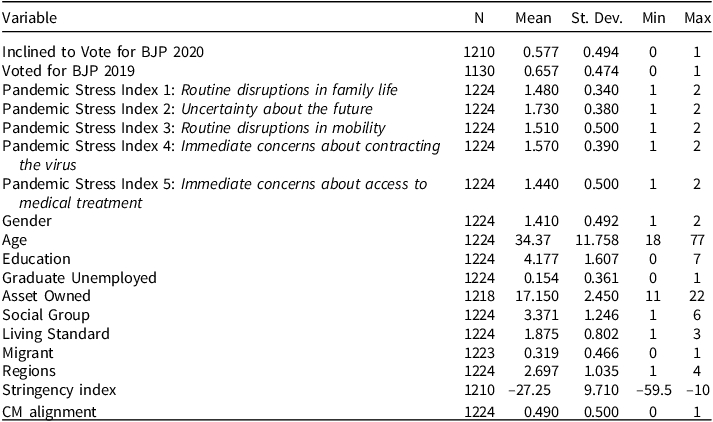
Table 2. Week 2 descriptive statistics
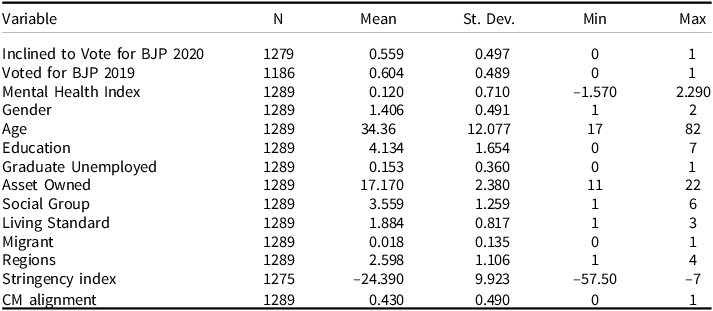
Table 3. Week 3 descriptive statistics
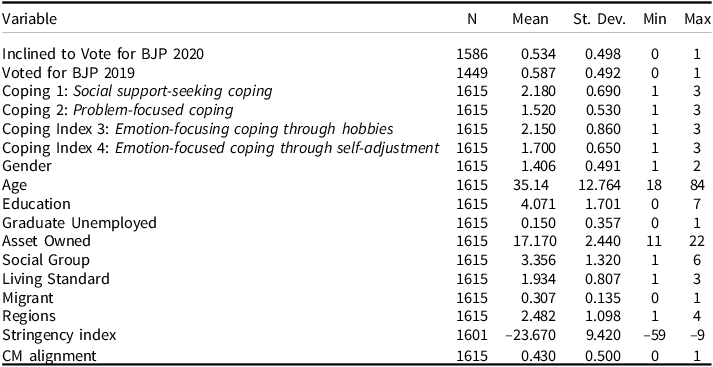
Results
Given the binary structure of our dependent variable, we assess H1–H4 by estimating weighted logistic regression models. We estimated ordinary standard errors for the core analysis, following Abadie et al. (Reference Abadie, Athey, Imbens and Wooldridge2022), who recommend against using clustered standard errors when all clusters in the population – states/union territories in our case – are included in the sample.Footnote 16 We begin by running a regression model excluding the interaction effects (Table 4). We use this model as our benchmark before incorporating the interaction effects.
Table 4. Inclination to vote for BJP in 2020
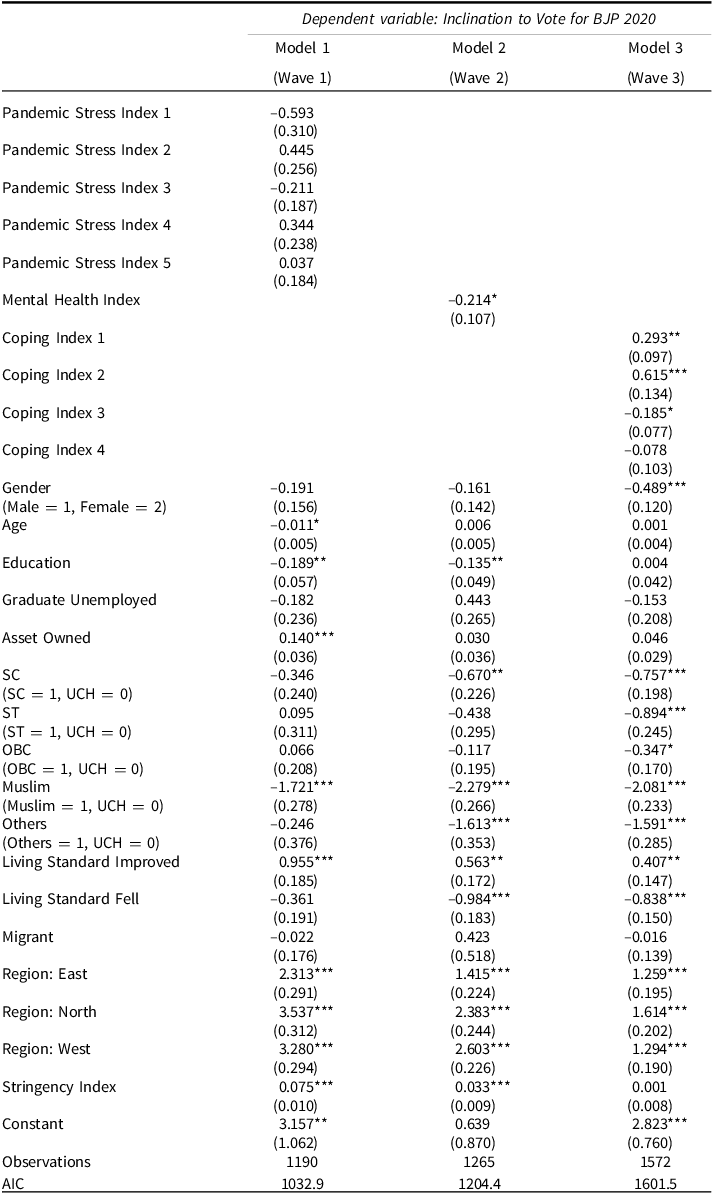
Note: *p < 0.05; **p < 0.01; ***p < 0.001; Standard errors in parentheses below coefficients.
A key finding from our benchmark model is that the estimated effects of our control variables broadly support our priors. In line with social identity theories, we find that Muslim respondents were consistently less likely to vote for the BJP across all weeks compared to non-Muslim respondents. The coefficients of the regional dummy variables also confirm our expectations, with respondents in the Eastern, Northern, and Western regions more likely to vote for the BJP than respondents in the southern states. Another variable that is consistently significant in the predicted direction across all weeks is our measure of perceived change in living standards, though the effects of our other economic covariates, asset ownership and graduate unemployment, are less determinate. Our prior on migrant status is also consistently confirmed. The coefficient of migrant status is insignificant across all weeks indicating that the central government’s quick response in terms of expanding workfare may have neutralized distrust among this group. The remaining control variables, however, vary in their effects by week. Specifically, female respondents were less inclined to vote for the BJP in Week 3; older respondents were less inclined to vote for the BJP in Week 1; educated respondents were less inclined to vote for the BJP in Week 1 and Week 2; SC and other minority group respondents were less inclined to vote for the BJP in Week 2 and Week 3; and ST and OBC respondents were associated with a lower chance of voting for the BJP in Week 3.
Having identified and controlled for several substantively important sources of omitted variable bias we now turn to the central variables of interest in this study. We see that, consistent with our predictions, in Week 1, increase in pandemic-induced non-social stress is uncorrelated with the inclination to vote for the BJP in 2020; in Week 2, worsening mental health is associated with a lower chance of voting for the BJP in 2020; in Week 3, respondents who used social support-seeking and problem-focused coping strategies were associated with a greater inclination to vote for the BJP, whereas respondents who used emotion-focused coping strategies through hobbies were associated with a lower inclination to vote for the BJP. Although these findings are promising, we note that, contrary to our predictions, increase in pandemic-induced social stress is uncorrelated with the inclination to vote for the BJP in 2020 in Week 1 (we expected a negative relationship), and similarly, use of emotion-focused coping through self-adjustment in Week 3 is uncorrelated with the inclination to the vote for the BJP in 2020 (we expected a negative relationship).
Next, we assess the potential moderating effect of governmental clarity of responsibility by incorporating interaction effects between our CM alignment measure and the psychological indicators (Table 5). Our findings show that the interaction effect model clearly outperforms the model without interaction effects.
Table 5. Inclination to vote for BJP in 2020 (including interaction effects with Chief Minister (CM) alignment)
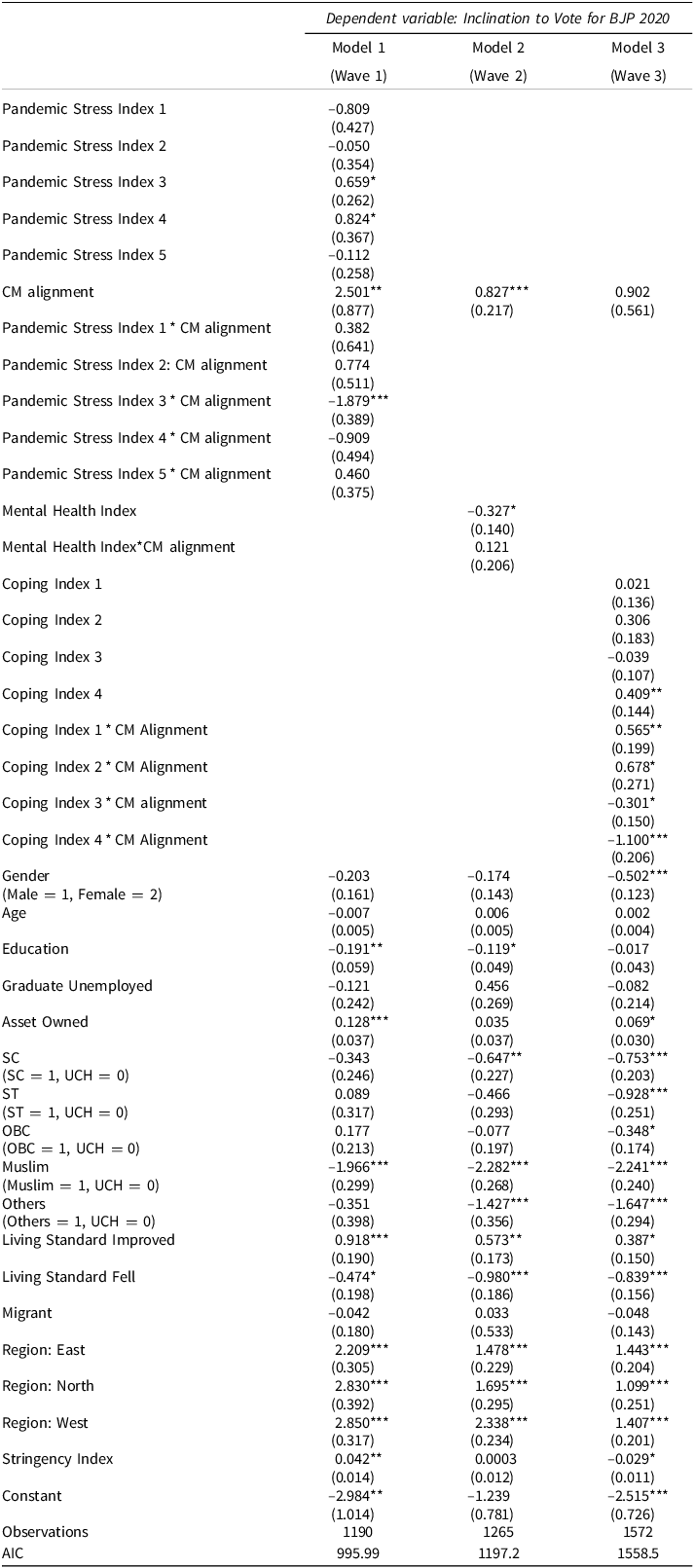
Note: *p < 0.05; **p < 0.01; ***p < 0.001; Standard errors in parentheses below coefficients.
To simplify our exposition, we discuss these results using marginal effects plots based on the coefficients reported in Table 5. To begin with, we see, that in Week 1, mental stress from routine disruptions in mobility has a statistically significant effect in the predicted direction. Assume that, all else equal, the index of routine disruptions in mobility (Pandemic Stress Index 3) increases from its minimum value, i.e. the respondent reported the absence of mental stress from feeling trapped/loss of freedom (1), to its maximum value, i.e. the respondent reported the presence of mental stress from feeling trapped/loss of freedom (2). We note that the average predicted chance of a respondent in a non-BJP-aligned state voting for the party in 2020 increases from roughly 6% to roughly 11%, but the effect runs in the opposite direction for respondents in BJP-aligned states, dropping sharply from roughly 23% to 8%. Figure 1 plots these effects with 95% confidence intervals.
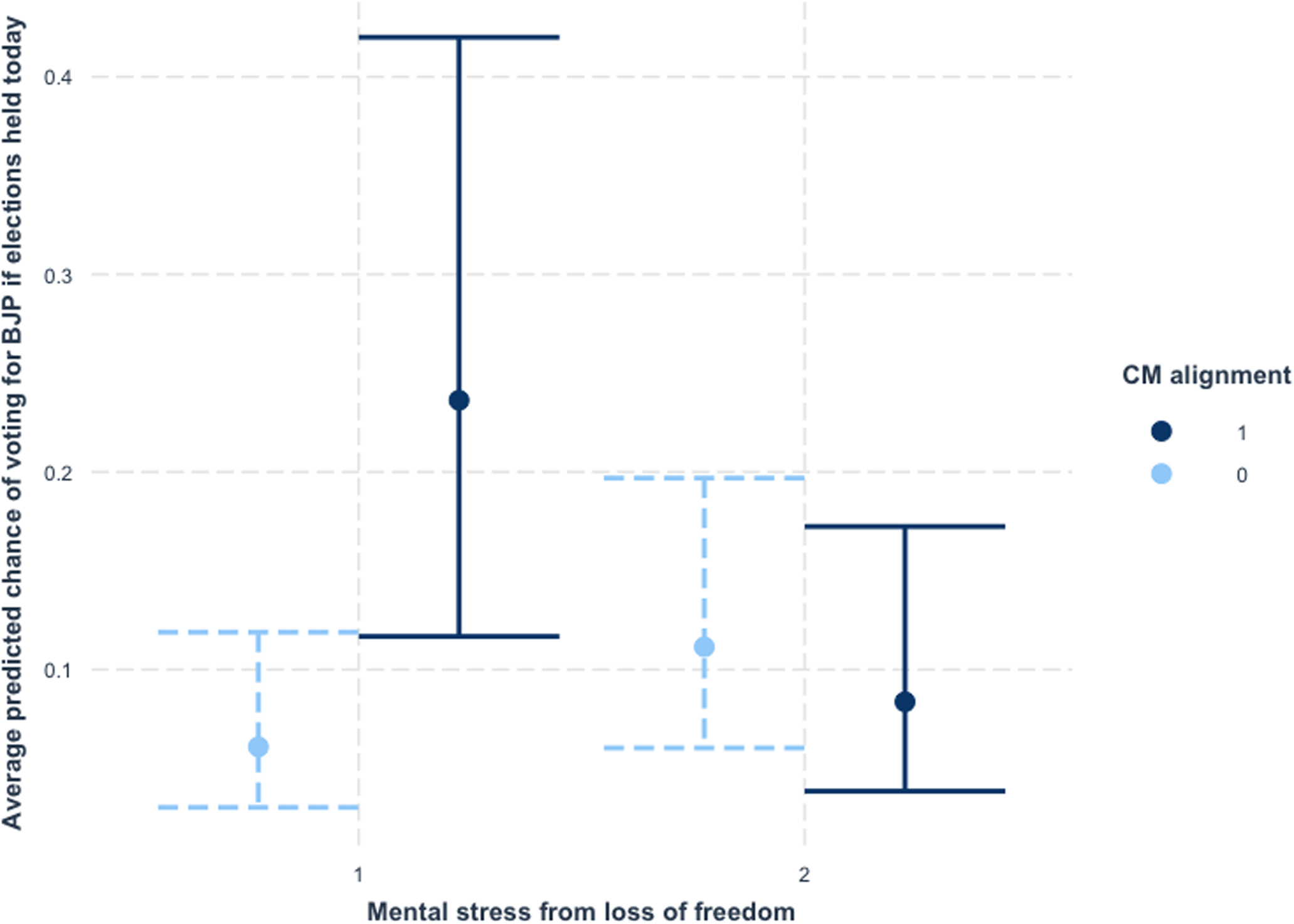
Figure 1. The effect of pandemic stress from routine disruptions in mobility on voting for the BJP in Week 1.
Moving on to Week 2, we see that the Mental Health Index has a statistically significant effect in the predicted direction, but this does not vary between BJP and non-BJP-aligned states. Assume, all else equal, a change in the Mental Health Index in non-BJP-aligned states from its mean value (0.09) to one standard deviation above its mean value (0.82). The average predicted chance of voting for the BJP drops from roughly 24% to roughly 20%. Now assume, all else equal, a similar change in the index in BJP-aligned states from its mean value (0.17) to one standard deviation above its mean value (0.84). The average predicted chance of voting for the BJP drops from roughly 43% to roughly 39%, a similar magnitude as in the non-BJP-aligned states. Figure 2 plots these results with 95% confidence intervals.
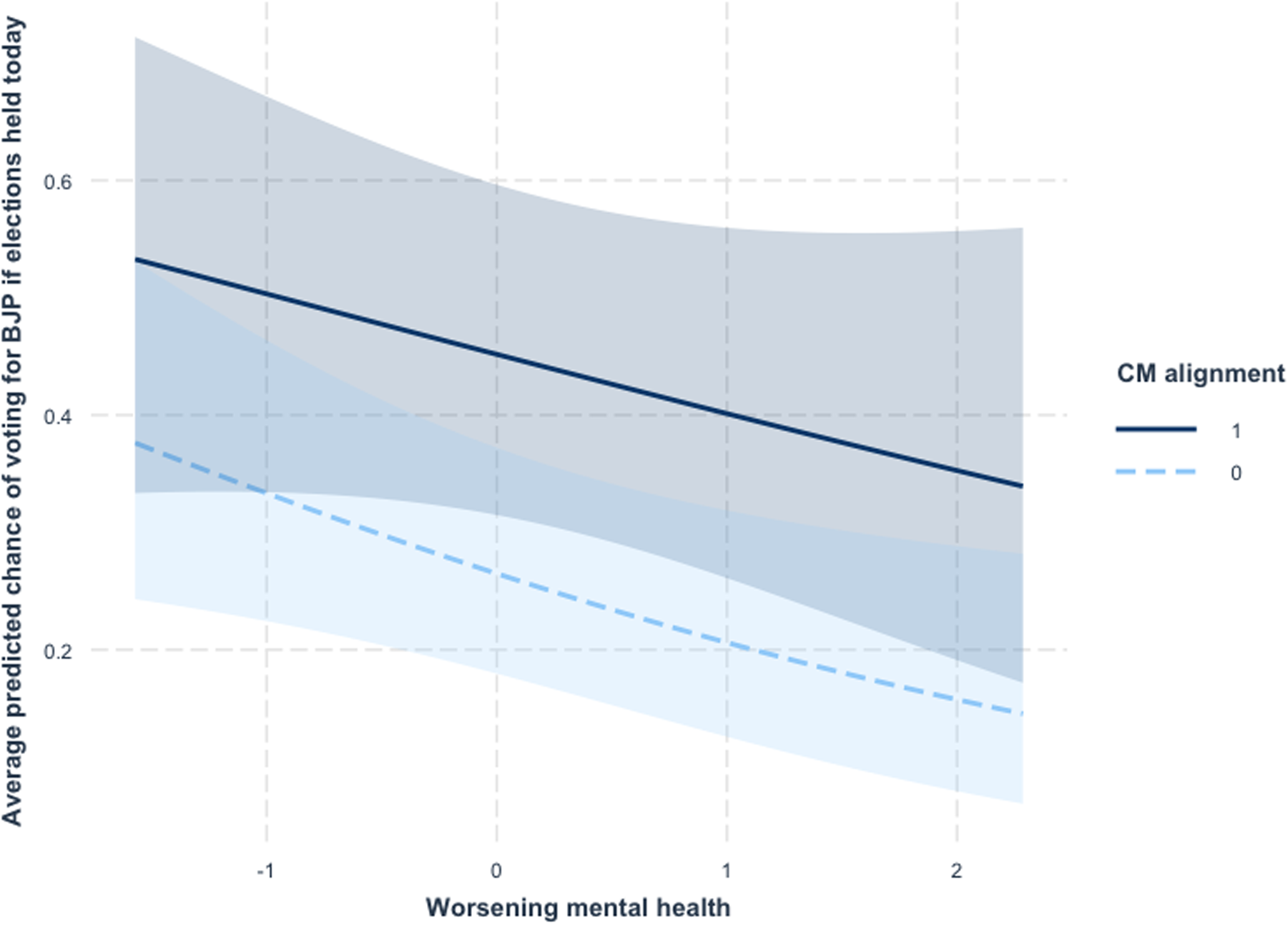
Figure 2. The effect of worsening mental health on voting for the BJP in Week 2.
Our findings for coping in Week 3 are also consistent with our predictions. We find that the effects of social support-seeking coping, problem-focused coping, and emotion-focused coping through hobbies and self-adjustment are all statistically significant in the predicted directions and vary systematically between BJP and non-BJP-aligned states. To understand these effects, let us begin with our index of social support-seeking coping (Coping Index 1). Assume, all else equal, a change in the index in non-BJP-aligned states from its mean value (2.10) to one standard deviation above its mean value (2.81). The average predicted chance of voting for the BJP increases marginally from roughly 44.5% to roughly 45%. Now assume, all else equal, a similar change in the index in BJP-aligned states from its mean value (2.29) to one standard deviation above its mean value (2.94). The average predicted chance of voting for the BJP increases sharply from roughly 60% to roughly 69%. Figure 3 plots these effects with 95% confidence intervals.

Figure 3. The effect of social support-seeking coping on voting for the BJP in Week 3.
Moving on to our index of problem-focused coping (Coping Index 2), assume, all else equal, a change in the index in non-BJP-aligned states from its mean value (1.43) to one standard deviation above its mean value (1.93). We note that the average predicted chance of voting for the BJP increases from roughly 44.5% to roughly 48%. Now assume, all else equal, a similar change in the index in BJP-aligned states from its mean value (1.64) to one standard deviation above its mean value (2.19). The average predicted chance of voting for the BJP increases sharply from roughly 60% to roughly 72%. Figure 4 plots these effects with 95% confidence intervals.
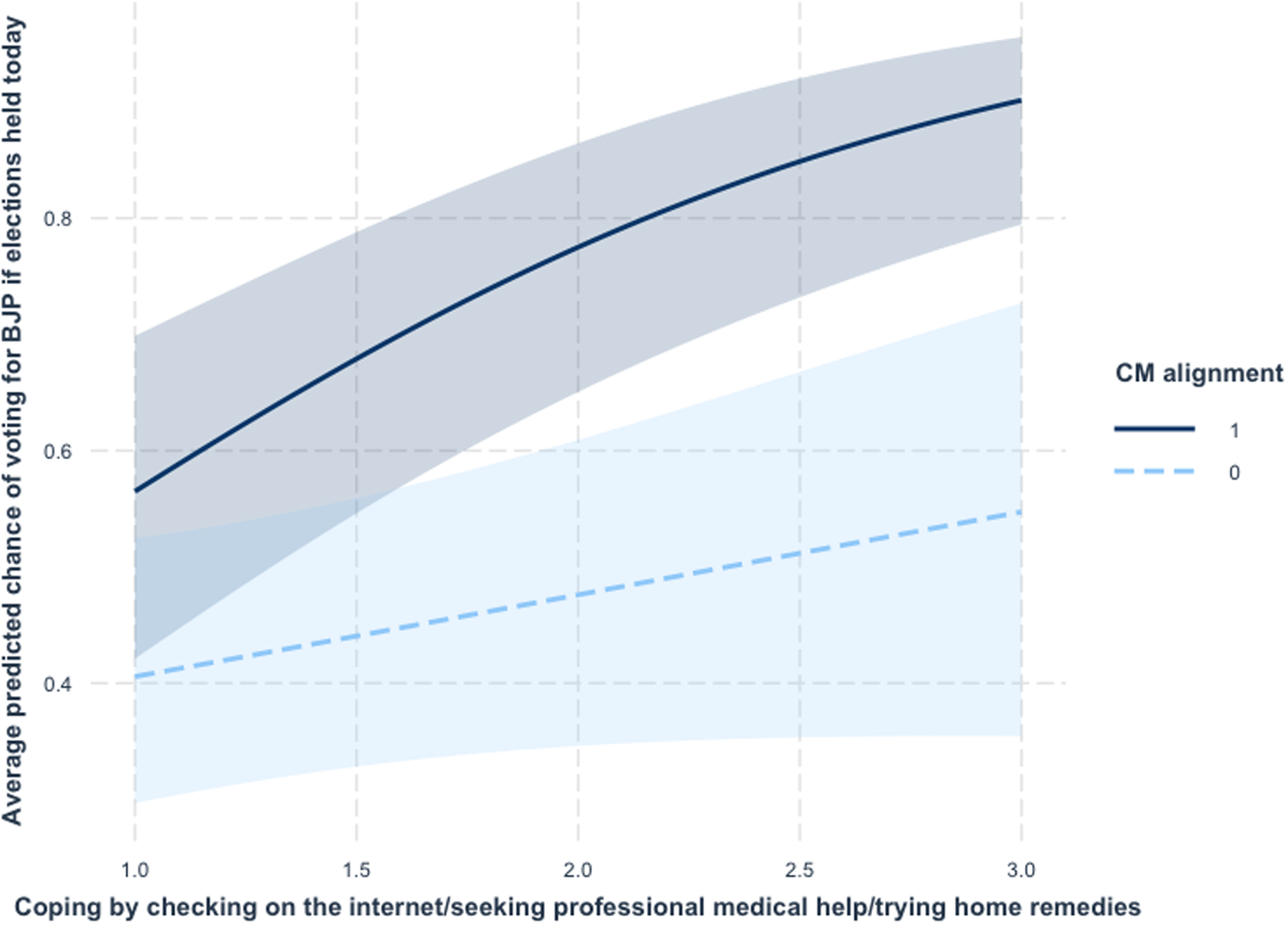
Figure 4. The effect of problem-focused coping on voting for the BJP in Week 3.
Next, we examine our index of emotion-focused coping through hobbies (Coping Index 3). Assume, all else equal, a change in the index in non-BJP-aligned states from its mean value (2.06) to one standard deviation above its mean value (2.93). We note that the average predicted chance of voting for the BJP decreases marginally from roughly 44.5% to roughly 44%. Now assume, all else equal, a similar change in the index in BJP-aligned states from its mean value (2.28) to one standard deviation above its mean value (3.10). The average predicted chance of voting for the BJP decreases from roughly 60% to roughly 53%. Figure 5 plots these effects with 95% confidence intervals.
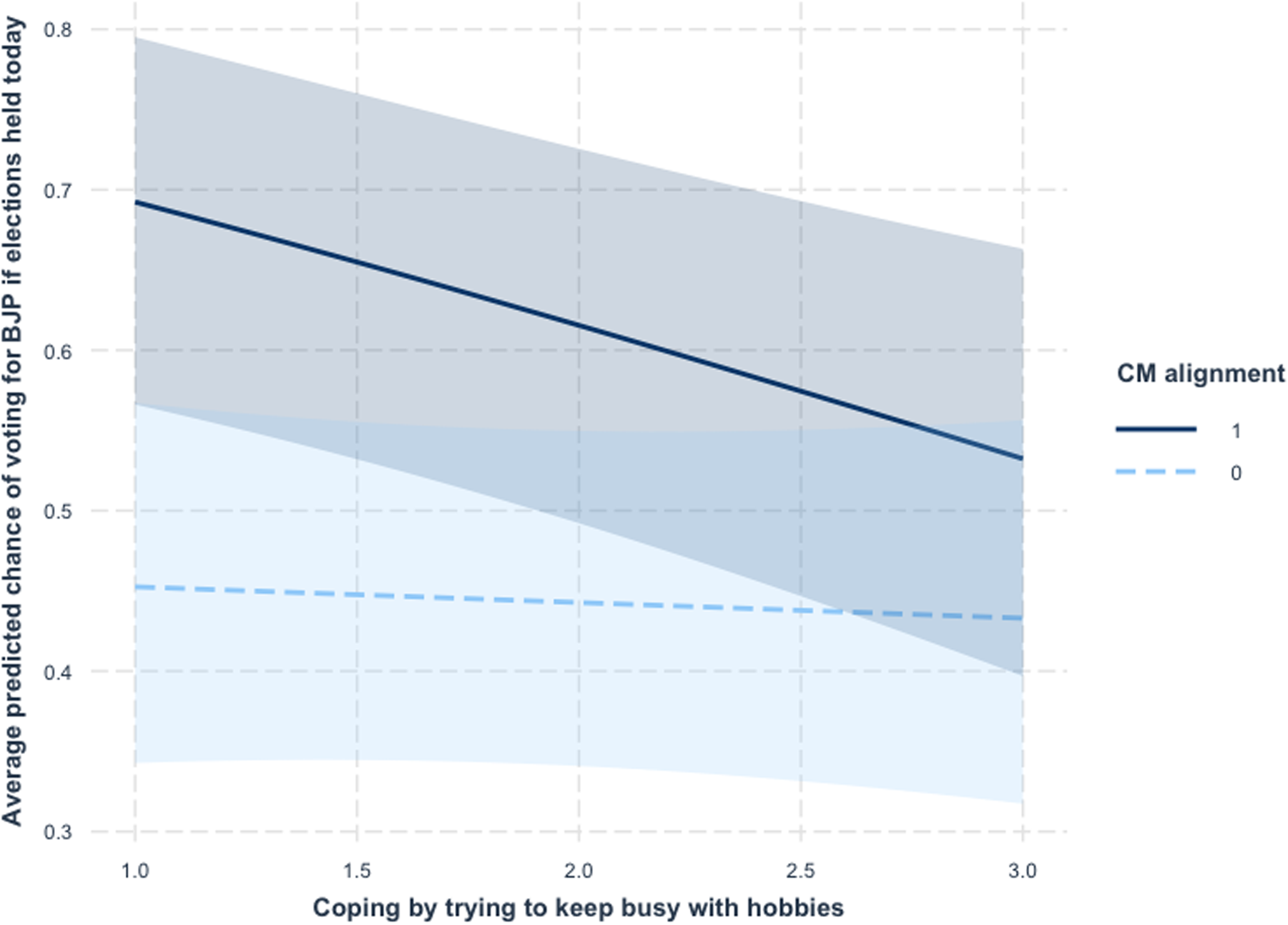
Figure 5. The effect of emotion-focused coping through hobbies on voting for the BJP in Week 3.
Finally, we probe our index of emotion-focused coping through self-adjustment (Coping Index 4). Assume, all else equal, a change in the index in non-BJP-aligned states from its mean value (1.64) to one standard deviation above its mean value (2.29). We note that the average predicted chance of voting for the BJP increases from roughly 44.5% to roughly 51%. Now assume, all else equal, a similar change in the index in BJP-aligned states from its mean value (1.78) to one standard deviation above its mean value (2.42). The average predicted chance of voting for the BJP decreases sharply from roughly 60% to roughly 49%. Figure 6 plots these effects with 95% confidence intervals.
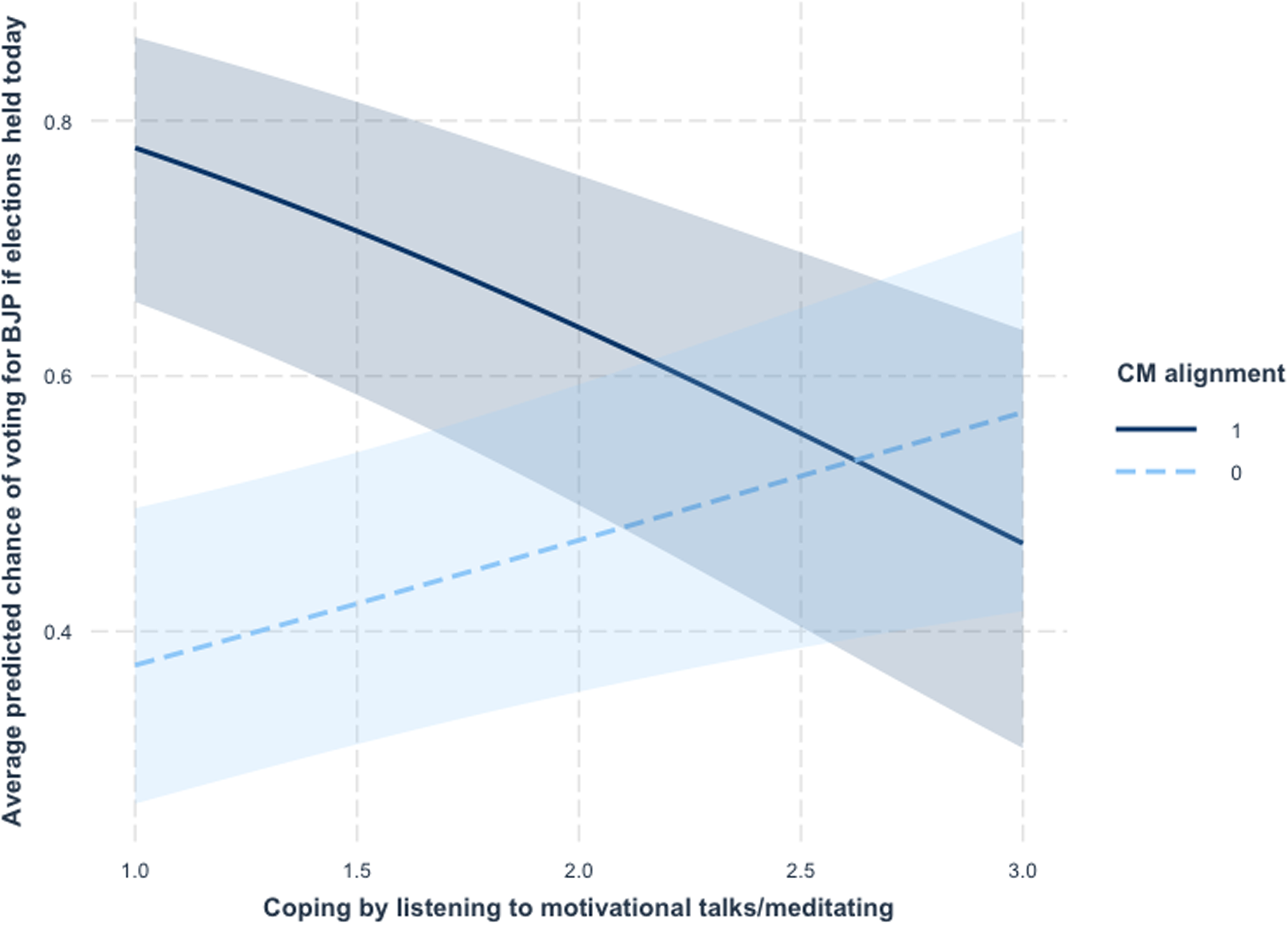
Figure 6. The effect of emotion-focused coping through self-adjustment on voting for the BJP in Week 3.
To summarize, our baseline regression findings are broadly consistent with our expectations. Two caveats are, however, worth noting. First, regardless of whether we model interaction effects or not, our index of stress from routine disruptions to family life is always statistically insignificant at the 0.05 level. Reassuringly, though, it is always significant at the 0.10 level and the sign of the effect is always in the predicted direction. Second, the interaction effects between our psychological indicators and the partisan alignment variable are stronger in Week 3. We note, however, this may simply be an artifact of the gradual shifting of pandemic management responsibility from the central government to state governments across time. Consequently, partisan alignments may have been more useful as a cue for assessing the incumbent party in Week 3 than in the previous weeks.
Robustness checks
To assess the robustness of our baseline regressions we ran a series of sensitivity tests.Footnote 17 We began by estimating a model with vote choice in 2019 as an independent variable to account for the possible effects of partisanship. Second, we assessed whether our findings are affected if the simple factor indices we used to operationalize our indicators of psychological distress are replaced by refined factor indices, which incorporate the exact contribution of each item to a latent factor. Third, we estimated a random effects model to control for unobserved state/union territory level heterogeneity. The random effects specification was used instead of fixed effects since our econometric framework has independent variables that are evaluated at the level of the state/union territory. Fourth, we estimated models with standard errors clustered at the level of the state/union territory. Next, we estimated a model using an alternate dependent variable. Specifically, we use a survey item that asked whether the respondent was very satisfied, satisfied to some extent, or very dissatisfied with the performance of the Prime Minister. Given the ordinal structure of the variable, we estimated an ordinal logistic regression model. Finally, we conducted a sub-sample analysis by estimating our model on a randomly chosen subset of 50% of the observations in our sample.
We note some interesting differences from our baseline findings. Including the 2019 vote depressed the effect of the mental health variable in Week 2, thus confirming our concern about the “over-controlling” effect of past vote. Clustering the standard errors both increased and decreased the uncertainty of some of our estimates, supporting Abadie et al.’s (Reference Abadie, Athey, Imbens and Wooldridge2022) recommendation to avoid using this approach when all clusters are included in the sample. Interaction effects were less salient in the model with the alternate dependent model, indicating that state-level heterogeneity was less relevant for voters when they assessed the Prime Minister. In general, pandemic stress from loss of freedom and emotion-focused coping through self-adjustment were the best performing among our psychological predictors across these specifications. Overall, though, our core proposition remains robust throughout: psychological distress shaped political attitudes in the midst of the pandemic and this effect was conditional on the source of psychological distress and moderated by governmental clarity of responsibility.
Conclusion
Extant research on psychological distress from COVID-19 and its effects on trust in government offers indeterminate answers on a vital question for contemporary public policy and democratic theory. While one strand of this research offers that pandemic-induced anxiety increased trust in government, another argues exactly the opposite, namely, pandemic-induced stress and poor mental health produced negative assessments of incumbent performance during the pandemic. While these divergent predictions are to some extent artifacts of the different samples analyzed in this research – samples vary by country, region, and the phase of the pandemic being assessed – we offer a way forward for future research through a theoretical intervention. Specifically, we hypothesize that only particular types of psychological distress created by executive actions in times of crises will be punished by voters, especially when governmental clarity of responsibility is high. We also take a first step toward testing our hypotheses by analyzing novel cross-sectional survey data with random national samples over three weeks in June 2020 in the midst of the first onset of the COVID-19 pandemic in India. Our findings broadly support our theory of political accountability in pandemic-like settings.
The results of this study are limited to June 2020, the immediate period of the opening up after the strict national lockdown in India of more than 8 weeks. These results are not meant to be the basis for generalization to subsequent pandemic contexts nor to subnational electoral contexts, because different dynamics likely were at play. Nevertheless, it is instructive to note that in the recently concluded national elections in June 2024, the BJP was deprived of an absolute majority of seats in the country, which it has held since 2014. The largest number of seats were lost by the party in Uttar Pradesh (UP), India’s largest state geographically and population-wise, where the party also led the state-level government since 2017 (Lin and Reed Reference Lin and Reed2024). UP was among the worst-affected of Indian states during the severe second wave of the pandemic in 2021 (Kumar Reference Kumar2021). It is plausible that the pandemic stress in UP may have been exacerbated by post-COVID-19 economic stress, among other local reasons for BJP’s seat losses. India’s rapid return to a global high of 7.8% in GDP growth rate in 2023, according to the World Bank, does not tell the entire story of economic recovery from the pandemic, which has been uneven both across and within states (Mittal et al. Reference Mittal, Steinert and Vollmer2023).
Our analysis also points towards new research directions. Our research design does not afford studying the same individual through different waves of the pandemic. Yet, such data is clearly needed for explaining voter behavior in cases like UP. Hence, a logical next step for future research is to study the evolution of political attitudes and mental well-being across all the phases of a pandemic as well as in the pre- and post-pandemic phases. Related to this, another worthy area for future research is the linkages between social and non-social sources of stress across time, a topic we abstract from in this study. Most importantly, future research should further refine the psychological categories we analyze in this study to better reconcile the needs of pandemic governance with political accountability. We note that these and similar lines of inquiry can be the basis of a very productive research agenda at the intersection of public opinion, public policy, and public health.
Supplementary material
The supplementary material for this article can be found at https://doi.org/10.1017/S0143814X25100688
Data availability statement
Replication materials are available in the Journal of Public Policy Dataverse at https://doi.org/10.7910/DVN/DAAKZ5.
Acknowledgements
The authors would like to thank panel participants at the 2021 World Association for Public Opinion Research-Asia Conference for their useful comments on an earlier version of the manuscript. Special thanks are due to Yashwant Deshmukh, founder of Centre for Voting Opinion & Trends in Election Research (CVoter), and CVoter Foundation, for generously sharing the survey data utilized in this study. The usual disclaimer applies.
Funding statement
There is no funding source to report for this manuscript.
Competing interests
There is no conflict of interest to report for this manuscript.
Ethical statement
The journal’s submission guidelines require that research involving human subjects must secure IRB approval. The questionnaire and design of the anonymized surveys on which this study is based were developed by CVoter and data was generously made available to us by CVoter Foundation for secondary analysis. CVoter is a survey research firm founded more than two decades ago in India that adheres to World Association for Public Opinion Research (WAPOR) and American Association for Public Opinion Research (AAPOR) data standards. The questions used in our analysis are found in election studies in many countries, such as evaluations of political leaders, household economic perceptions over the past 12 months, local issues, past vote, vote intention, and demographics. CVoter’s telephone surveys are typically short (about 11 minutes) cross-sectional surveys conducted using random digit dial representative samples and Computer Assisted Telephone interviewing software. CVoter Foundation gifted these data to us, which will be shared for replication and deposited in a public archive.

